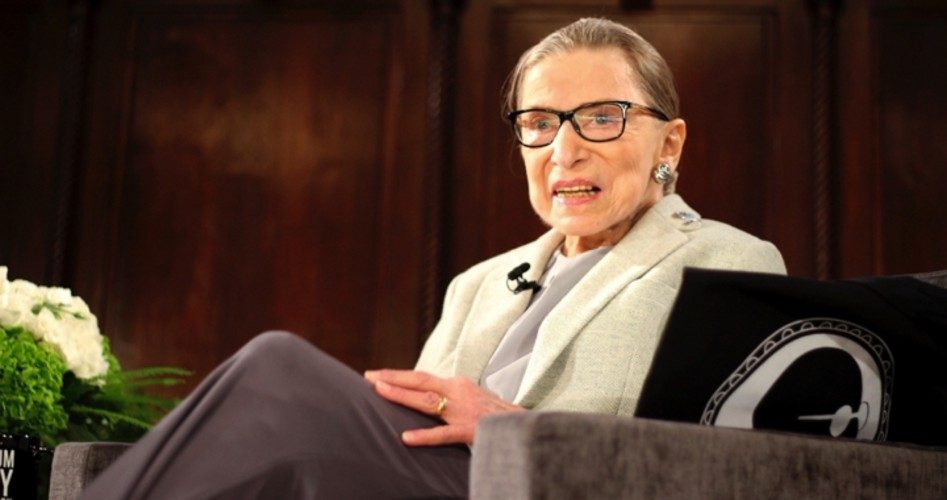
Supreme Court Justice Ruth Bader Ginsburg’s cancer surgery on December 21, at which time half of her left lung was removed because of two separate cancerous growths, has left her unable to attend several sessions of the Supreme Court, leading to much speculation as to not only her own survival, but how her illness could impact the Supreme Court. Because the role of the Supreme Court in our system of government has grown so much in the past century, every vacancy or potential vacancy on the Court is watched with much anxiety across the political spectrum.
Raja Flores, the chief of the division of thoracic surgery at Mount Sinai Hospital in New York, told CNBC that Ginsburg’s post-operative recovery could take several weeks, but she could be back at work sometime in February. Ginsburg, who is now 85 years old, has reportedly been given transcripts of oral arguments, and case briefs to read at home during her recovery. She was seen this week being helped from a wheelchair into an automobile, but it was not revealed where she was being taken.
Ginsburg has had multiple bouts with cancer. In 1999, she had colon cancer, then had pancreatic cancer in 2009. Pancreatic cancer has a very low survival rate — less than 10 percent — but Ginsburg is still living a decade later. This, however, is the first time that an illness has forced her to be absent from the Court. Her latest cancer diagnosis happened after she fell in November, fracturing several ribs. It was during her treatment for the broken ribs that physicians at George Washington University Hospital discovered two cancerous growths on her left lung, but no other cancers were detected.
Because of her advanced age — she is now the fourth-longest serving member of the Supreme Court — many liberals urged her to retire before the 2016 election, and let President Barack Obama nominate her successor. She defiantly refused, vowing to stay on the bench for another five years.
{modulepos inner_text_ad}
Even if Ginsburg, who was first named to the court by President Bill Clinton, had stepped down during Obama’s last year, any nomination Obama made to replace her would have almost certainly suffered the same fate as his picking of Merrick Garland to replace Antonin Scalia. With Garland, Senate Majority Leader Mitch McConnell, citing precedent and statements made by Vice President Joe Biden, when he was in the Senate, refused to even consider Garland, as it was a presidential election year.
When Donald Trump then won the presidency, he named Neal Gorsuch to take Scalia’s place on the Supreme Court, and he won confirmation in the Republican-majority Senate. President Trump later named Brett Kavanaugh to take the spot of Anthony Kennedy, who retired, and Kavanaugh was confirmed after a highly contentious confirmation hearing in the Senate.
Gorsuch’s replacement of Scalia did not signal much of an ideological shift on the Supreme Court. Kennedy was nowhere near as reliable on holding to a strict construction of the Constitution as Scalia, causing the Kavanaugh nomination to be much more hotly contested, as conservatives hoped he would be better than Kennedy, and liberals feared that he would.
Were Ginsburg to vacate the Court, however, any nomination by Trump would be viewed as, at least potentially, a profound shift in the ideological balance of the Court. For example, many view Amy Comey Barrett, or someone with similar views, as a likely nominee — and with the Roe v. Wade decision likely to be drastically modified, or reversed altogether, such a nomination would touch off perhaps the most hotly contested confirmation battle in U.S. history.
If Ginsburg can hang on until after the 2020 presidential election, which the Left hopes will result in the defeat of President Trump by one of the hard-Left Democratic Party hopefuls, that president could name an ideological sister (or less likely, brother, as Democrats are essentially locked into identity politics) whenever Ginsburg either retires or dies.
It is quite clear that were Ginsburg to leave the Court, for whatever reason, in 2019, the Democrats would fight tooth-and-nail against Barrett or any other Trump nominee, but in the end, with 53 Republicans in the Senate, Trump’s pick would almost certainly be confirmed — even if unreliable senators such as Susan Collins voted “no.”
But Republicans should also worry about a Ginsburg retirement or death in 2020. After all, the Republicans firmly established the “principle” that a vacancy during a presidential election year should not be filled until after the election. While Democrats routinely abandon principle when it comes to advancing their goals, Republicans tend to be more likely to honor such concepts, and there is no doubt that Senate Minority Leader Chuck Schumer and others would loudly remind them of their 2016 stance.
Even more important, the mainstream media, which is essentially an arm of the Democratic Party and is ideologically left-wing, would not only provide Schumer and others a microphone to make this argument, they would make the argument themselves loudly and often.
If Ginsburg is still on the Supreme Court during the 2020 campaign, she would no doubt become a hugely important issue between Trump and his Democratic Party-nominated challenger.
Photo: AP Images



